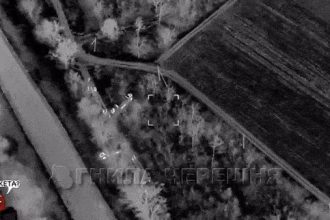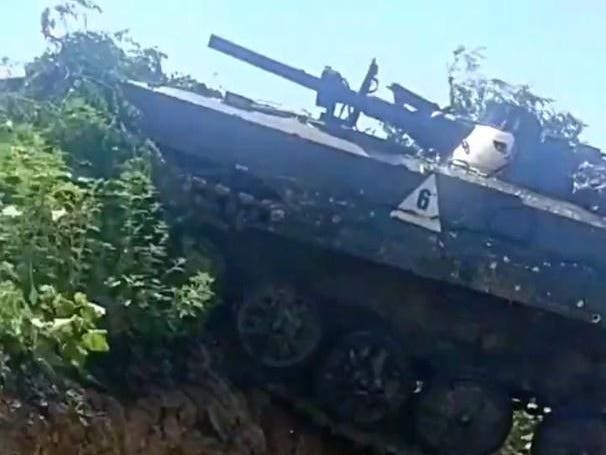The Ukrainian armed forces this week launched the second phase of their 2023 counteroffensive, seven weeks after their initial assaults along at least four axes in Zaporizhzhia and Donetsk Oblasts in southern Ukraine, as well as around the Russian-occupied city of Bakhmut in eastern Ukraine’s Donbas region.
On the axis between Mala Tokmachka and Robotyne in Zaporizhzhia, this second phase apparently began with an oddball attempt by Ukrainian troops to probe a suspected minefield a mile northwest of Russian-occupied Verbove.
Videos Russian troops posted online on Thursday depict an old Ukrainian BMP-1 fighting vehicle rolling from a treeline across an open field. It’s likely the 1960s-vintage, 14-ton infantry fighting vehicle is crewless. At least one person is visible running away from the IFV, apparently after jamming the throttle and bailing out.
The BMP rolls across the field without triggering any mines, then runs afoul of an anti-tank ditch that’s slightly too wide for the IFV to cross. The BMP gets trapped in the trench, where Russian troops later inspect it.
The BMP hijinks are telling. First, they’re further evidence that Ukrainian formations—seemingly including the 47th, 65th and 118th Mechanized Brigades—are advancing around Robotyne, a key Russian strongpoint on the road toward occupied Melitopol, 40 miles to the south.
They likewise are indicative of the paucity of Russian forces along some of the most important sectors of the front line. Not only does the unmanned BMP not hit any mines—it also takes no fire as it trundles into the anti-tank trench. The trench, and a line of concrete anti-tank obstacles behind it, could impede a Ukrainian advance toward Verbove. But static defenses work best when they’re manned.
That the Russians seemingly are stretched a bit thin should come as no surprise. After suffering heavy losses in vehicles and people in the first few days of the counteroffensive in early June, especially between Mala Tokmachka and Robotyne, Ukrainian commanders deliberately slowed their assault—opting to minimize their own troops’ casualties while leveraging their fast-improving artillery capabilities to inflict equal losses on the Russians.
The nearly one-to-one casualty ratio in the first phase of the counteroffensive defies historical precedent. Typically, an attacker suffers three times as many losses as a defender does, owing to the latter’s ability to dig in and stay behind cover. In losing as many troops and vehicles as the Ukrainians, the Russians also are losing their defensive advantage.
It was inevitable that partial gaps would appear in the two main defensive lines stretching across southern Ukraine. That crewless BMP’s comic assault outside Verbove might be one of the first times Ukrainian ground forces came in direct contact with the northernmost line.
Actually penetrating that line will take more than one unmanned fighting vehicle. The BMP may not have triggered any mines, but it’s a safe bet there are mines—perhaps thousands of them—between the Ukrainian 47th, 65th and 118th Brigades and the Russian strongpoints in Robotyne and Verbove.
Mines, in particular the 17-pound TM-62, are the biggest threat to advancing Ukrainian forces. The next time Kyiv’s troops make a move on that trenchline outside Verbove—if they haven’t already done so—expect manned mineclearers to lead the way. That self-sacrificing BMP merely revealed the possible relative thinness of the minefield outside Verbove. It didn’t prove there are no mines.
The Ukrainian assault force will need bridgelayers, too, so that manned tanks and IFVs don’t get jammed up in the trench the way that crewless BMP did. As it happens, this is an eventuality the Ukrainian army has been preparing for. It’s built up a sizeable force of armored bridgelaying vehicles.
The unmanned BMP didn’t trigger a rapid Russian response outside Verbove, but Ukrainian commanders can’t always count on similar lethargy across the Robotyne axis.
A Ukrainian assault on a Russian trench, half a mile west of the crewless BMP’s foray and apparently on the same day, suffered heavy losses from artillery, missiles and explosive drones. The assault force’s survivors left behind two T-72s and as many as nine BMPs.
Read the full article here





